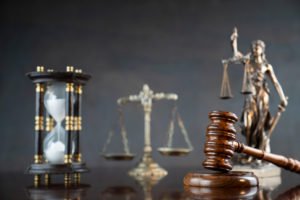
“You kill a dog; you go to jail. You kill a little black boy, nothing happens.”
Attorney Ben Crump spoke these words on October 12, 2007, after the justice system failed Martin Lee Anderson, a 14-year-old African-American boy who was murdered at a Florida juvenile boot-camp detention facility. Little did Crump know that five years later, his approach as the go-to lawyer for a modern civil rights movement would take him to the courtroom for the unjustified death of another “little black boy.”
The Trayvon Martin case would shine a spotlight on the undeniable fierceness Crump has against the systemic racism crippling Black America, and ignite a movement that would change Americans’ view of the justice system.
Unfortunately, on July 13, 2012, the man who murdered Martin, George Zimmerman, was found not guilty after only 16 hours of deliberations by a jury on a case that took over a year to close. Al Sharpton responded, sharing he feels it is a “slap in the face to those that believe in justice in this country.”
While this outcome only reinforces the narrative that Black lives do not matter to the White justice system, Mr. Crump will not falter because of these injustices. He will use them to strengthen his stance as the “Black People’s Attorney General,” fighting for Black and marginalized communities across the nation.
The Murder of Trayvon Martin
On February 26, 2012, at approximately 7 pm, in the Twin Lakes community in Sanford, Florida, 17-year-old Trayvon Martin was walking back from 7/11. It was raining, and Trayvon was carrying a bag of skittles and a can of iced tea. George Zimmerman drives through the neighborhood and spots Trayvon, calls the police non-emergency line, and reports a “suspicious person” walking through the gated community. Trayvon is followed by Zimmerman, who is on the phone with the dispatcher who tells Zimmerman he does not need to follow him.
Ten minutes later, while Trayvon is on the phone with his girlfriend, the two have an altercation. Zimmerman testified that Trayvon attacked him, punching him in the nose and smashing his head against the concrete. Trayvon’s girlfriend testifies she heard another person on the phone asking Trayvon what he was doing, to which he replies, asking the man why he was following him. She says she heard what she assumes is an altercation and then lost connection.
At this point, Zimmerman is the only person to know what happened next. According to Zimmerman, they exchange words, and Trayvon proceeds to attack him. At approximately 7:25 pm, Zimmerman shoots and kills Trayvon Martin.
There were multiple 911 calls from the neighbors that heard the gunshot, and what they said was someone screaming for help. When the police arrive, Zimmerman tells police that he shot Trayvon in self-defense. The police report shares that Zimmerman was bleeding from the nose and back of his head. No arrests were made.
The Trayvon Martin Case: A Timeline
February 27, 2012, Tracy Martin files a missing person’s report because his son Trayvon did not make it home from the store the night before. The police share a photo of his son, dead, at the crime scene, which confirms the John Doe from the night before is Trayvon Martin.
March 3, 2012, Trayvon Martin’s family lay his body to rest at Dade-Memorial Park in North Florida, a day after more than 1,000 friends and supporters attend the viewing of his body in support of his family.
March 8, 2012, Mr. Crump and Trayvon Martin’s parents, Sybrina Fulton and Tracy Martin, release that they are filing a wrongful death suit. During this news release, Crump demands that the police release the 911 tapes from the night of the shooting and arrest George Zimmerman.
Mrs. Fulton and Mr. Martin created a Change.org petition to push for the arrest of Zimmerman. The petition climbs 10,000 signatures an hour at its peak and ended with a total of 200,000 signatures after ten days.
The week of March 11, 2012, Mr. Crump and Martin’s parents hold interviews on news stations as the story gets nationwide attention. Police Chief Bill Lee reports that Zimmerman is not arrested because there is no evidence to disprove his self-defense claim. Florida State Attorney Norm Wolfinger takes the case.
March 16, 2012, 911 calls from the night of the event are released that prove that Zimmerman pursued Trayvon the night of the shooting. In one of the 911 calls, there are screams of help and a shot heard.
March 19, 2012, the Justice Department and FBI announce investigations. Florida Governor Rick Scott requests that the state assists in the investigations. The following day, Crump tells the media that he had spoken to the young woman on the phone with Trayvon Martin, moments before he was murdered. The young woman stated that while she was on the phone with Martin, he said, “this dude is following me,” moments before the call went silent.
March 21, 2012, Sanford City announces that they no longer have confidence in Chief Lee. The following day, he takes a temporary resignation. Activists take Trayvon’s case to the street, bringing rallies to several cities. Trayvon’s parents pair up at the demonstrations in Sanford, speaking out for their son’s justice.
March 23, 2012, President Barack Obama makes a public speech regarding Trayvon Martin’s case. Obama announces that he wants to see the Trayvon Martin case thoroughly investigated, sharing the statement, “If I had a son, he’d look like Trayvon.”
April 5, 2012: Ben Crump and Trayvon’s Family Win Wrongful Death Suit
Mr. Crump and the family succeed in their wrongful death suit against the Homeowners Association of the Florida Subdivisions. The lawsuit settles for an undisclosed amount after the family reportedly rejected a previous $1 million offer.
Six days later, Zimmerman is arrested on second-degree murder charges. On April 18, 2012, Seminole Circuit Court Judge Jessica Recksiedler removes herself from the case and passes it to Seminole County Circuit Judge Kenneth Lester Jr., who approves Zimmermans $150,000 bond on April 20, 2012. Judge Lee then revokes Zimmerman’s bond on June 1, 2012, and gives him 48 hours to surrender himself after the court finds that he and his wife lied about their finances. The following months would prove challenging for the family as the media proceeds to twist the facts.
The Verdict
After more than a year in court, an all-female and mostly all-White jury found George Zimmerman innocent on all counts.
“Now because of these laws upheld by a jury in this trial where anyone walking committing no crime can be followed or approached by another civilian, and they can use deadly force and say it was self-defense, that is something that is frightening and cannot be allowed to sustain itself in our society,” Al Sharpton shared in a press release after the verdict. “… The clergy will come forward to deal with this new threat to civil and human rights in the 21st. Century. There is nothing more serious than our not being able to protect our children from unwanted, undeserved harm. There was not even the hint that Trayvon Martin did anything wrong.”
“…it’s OK to shoot and kill someone who is unarmed and not be held accountable is an awful message to send our teenagers,” Sabryna Fulton said, according to The Guardian. “They are afraid. They’re afraid to walk down the street in their own community. They’re afraid to listen to music. They’re afraid to wear hoodies. They’re afraid to go to the park and play. They’re afraid to be stopped by the police. They don’t even feel like they’re going to make it to 21 years old. We can’t have that message.”
These comments, made by Rev. Sharpton and Trayvon’s mother, Sabryna Fulton, following the verdict, outline why these unjust rulings will continue to affect Black families across the nation. Not only are they unjust, but they are another step back in the desegregation of America’s justice system. Nonetheless, although George Zimmerman continues to justify his actions by filing lawsuits against those who speak out against the verdict, Ben Crump will continue to fight for equality while relentlessly providing support for those who feel they do not have a voice.
A Compassionate Voice for Civil Rights and Justice
Many ask why Ben Crump continues to take on the fight for these high profile cases. The answer is because he wants to “take cases that not only will have an impact on the individual and their family but will have impact on society and impact many people,” according to an interview with Bloomberg Law.
Crump wants to make changes that reform laws based on White privilege. He wants to take the platform he has been given and provide a safe America for the next generation of Black and Brown people and all those who are marginalized and feel they are being silenced by a racist system that continues to push the false narrative of “justice for all.”
Ben Crump is a compassionate lawyer who is not scared to utilize the voice of change amidst these civil rights struggles when most would fear retribution. “From that day to this one, my objective has been to try to give people who are marginalized and disenfranchised a better shot at the American dream,” Crump said to the Tampa Bay Times.
About Trayvon Martin
TRAYVON BENJAMIN MARTIN was killed at the age of 17 walking home from a 7-11. Born and raised in Miami to Sybrina Fulton, a local government employee, and Tracy Martin, a truck driver, Trayvon was an average student who excelled at football, and dreamed of a career in aviation. He loved math, Tupac, video games, taking his cousins to Chuck E. Cheese, and watching reruns of Martin. He idolized his older brother Jhavaris. In February 2012, Trayvon, Jhavaris, and their mother celebrated her birthday with a horseback-riding trip. It was Trayvon’s first time on a horse, but he was a quick study. The horse kept acting out and picking on its peers, but Trayvon, in just a matter of minutes, got it to calm down and follow his instructions. When he was only nine years old, he pulled his father out of a fire that broke out in their home, saving his life.
Trayvon went to visit him in Sanford, Florida only a few days after his mother’s birthday. One night, he stepped out of the house to buy an Arizona and some Skittles. As he headed back, he caught the eye of an armed neighborhood crime-watch coordinator named George Zimmerman. Certain that this young Black teen in a hooded sweatshirt was up to no good, in a place he wasn’t welcome, Zimmerman dialed 9-11. Though the dispatcher told him to stop following Trayvon, Zimmerman hung up, and ignored them.
Trayvon Martin was only a few months away from his Junior prom, when his life was cut short by Zimmerman. But through the unspeakable tragedy of his death and Zimmerman’s eventual acquittal, the Black Lives Matter Movement was ignited as a powerful force for change, while a brutal reminder was served to the nation, that even with President Barack Obama’s re-election less than a year away, the epidemic of anti-Black violence was alive and well, and always had been.




